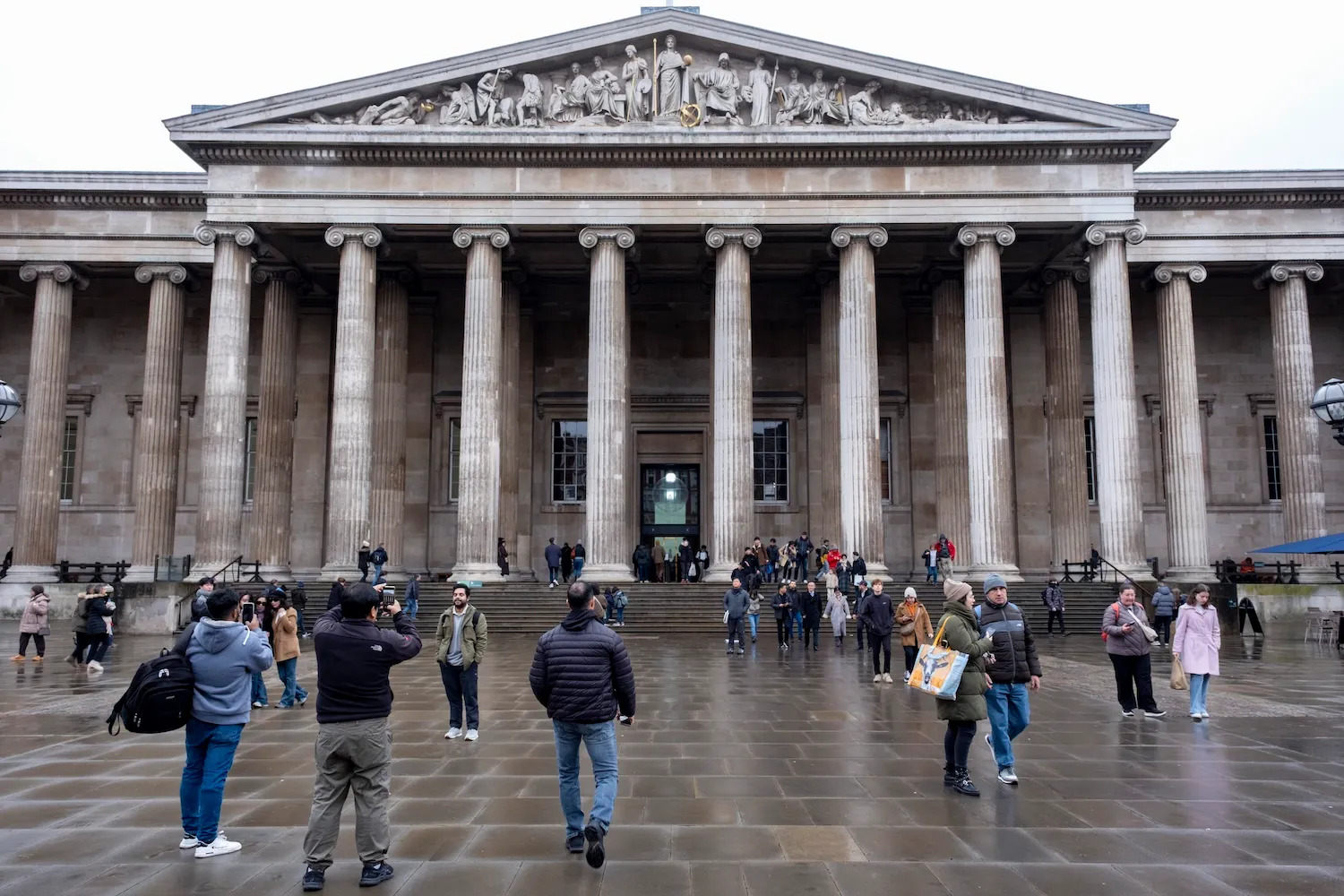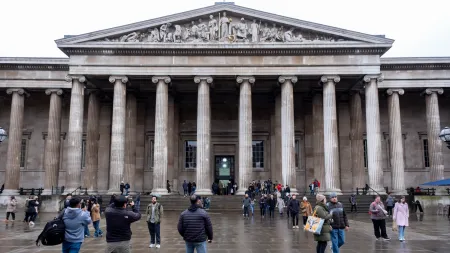
The British Museum, the world’s first free-to-the-public national museum, opened its doors in 1759. Founded in 1753 by an act of Parliament, after the physician and collector Hans Sloane bequeathed his collection to the nation, the museum immediately had a base of 71,000 items to oversee.
From its beginnings as Sloane’s “cabinet of curiosities,” the British Museum has grown in size, scope, and reputation over the past 266 years. Xerxes Mazda, the recently appointed director of collections, is now steward of some eight million objects. Here are ten that shouldn’t be missed on your visit.
-
Jōmon cooking pot, c. 5000 B.C.

Image Credit: British Museum. Considered the first people in the world to make pottery, the Japanese used vessels such as this one to boil food like shellfish and edible plants. Only about 6.5 inches square, this was very much a personal cooking pot, for fairly small portions of whatever had been brought back that day. The hunter-gatherers of prehistoric Japan hunted boar and deer in the winter and collected shellfish in summer and early autumn. A favorite food was clams, which you can imagine being boiled in this very vessel 7,000 years ago. Note the cordlike markings on this pot; the Jomon period is quite literally named after this typical decoration of the time, Jomon translating to “cord-marked.” This particular example was later lined with lacquered gold leaf on the interior during the 1800s to be converted into a water jar for tea ceremonies. One may wonder, did those 19th-century tea drinkers know what they were sipping from?
On display, Room 3
-
The Royal Game of Ur, Iraq, 2600 B.C.

Image Credit: British Museum. We don’t know the real name of the game played with this inlaid board, die, and markers, but it was extremely popular with the people of ancient Mesopotamia—boards for it have been found at archeological sites across the Middle East. Nobody knew how to play it until the 1980s, when British Museum curator Irving Finkel translated a cuneiform tablet written by a Babylonian astronomer in 177 B.C. and realized he was looking at the game’s rules. An unpredictable race between two players to move all their counters off the board, this game has stunningly modern gameplay. You can knock your opponent off the board, gain immunity, and win extra throws of your die. This particular set was excavated in southern Iraq, in the royal palace of Ur, in 1926 and is the oldest complete tabletop game ever found. If you want to test your skill, you can buy a copy in the British Museum shop.
On display in Room 56
-
Bust of Ramesses the Great, 1292–1189 B.C.

Image Credit: British Museum. Unceremoniously hacked off at the waist from where he originally sat as one of a seated pair flanking an entrance to his tomb complex, this granite bust of Ramesses II is 8 feet tall and over 6 feet wide. It was acquired by the British Museum in 1817 with the permission of the Egyptian governor, Muhammad Ali. (Later, in 1835, Ali banned all export of Egyptian antiquities, but not before the Rosetta Stone had left the country.) Ramesses II ascended the throne at the age of 25 and died at the extremely ripe old age of 90, meaning that many Egyptians would have lived knowing only one pharaoh. Part of the 19th Dynasty, Ramesses II is nearly as famous as the fashionably inbred generation of Akhenaten and his son Tutankhamun, and certainly he should be, as he’s said to have had upwards of 100 children between his 200 wives. He also named a new capital city after himself and is believed to have drawn up the first peace treaty between foreign powers—in this case between the Egyptians and the Hittites after the Battle of Kadesh.
On view, Room 4
-
Colossal statue of a winged lion from the Northwest Palace of Ashurnasirpal II in Assyria (modern-day Iraq), 883–859 B.C.

Image Credit: British Museum. Heartbreakingly razed by the terrorist organization ISIS in 2016, the ancient city of Nimrud, the capital of Assyria, was adorned with protective deities like this one, which measures an impressive 11.5 by 12 feet. Luckily, a few of these so-called lamassu survive in museums across the world. With a lion’s body, a bird’s wings, and a human head, the figures often flanked entrances to royal strongholds. (This particular sculpture’s five legs are meant to give realistic views of the creature both from the front and in profile.) Guarding doorways in Ashurnasirpal II’s palace, they may well have afforded the king of Assyria much-needed protection against his many enemies; famous for both his aggressive campaigns against neighboring peoples and his cruelty, Ashurnasirpal II exacted horrible punishments on his captives and subjects, including public flaying.
On display, Room 6a
-
Map of the world and the Flood Tablet, 700–500 B.C.

Image Credit: British Museum. Does the Old Testament’s account of Noah’s Ark describe a real event? This seemingly unassuming 5-inch by 3-inch clay map from ancient Mesopotamia (modern-day Iraq), the oldest known map of the world, suggests that it does. The map uses the ancient writing system of cuneiform, and though damaged and by no means complete, it remains readable. But what’s so amazing about this little tablet is what it maps: There is a double ring labeled “Bitter River,” a body of water surrounding the Babylonians’ known world, depicted as a circular land mass. A vertical line indicates the River Euphrates, and a rectangle in the upper half locates the ancient city of Babylon, but that isn’t even the best part. Three triangles emanate from the exterior circle, and incredibly, the text describing these triangles survived on the reverse of this tablet. One description mentions a great mountain and a “parsiktu vessel,” which is how the Babylonians referred to the remains of Noah’s Ark, which is said to have come to rest on Mount Ararat. Directly opposite the little triangle that labels the vessel is the Babylonian city of Urartu, which, translated from Assyrian to Hebrew, is Ararat. Wow.
On display, Room 55
-
Parthenon Marbles, 447–432 B.C.

Image Credit: British Museum. Where to start? One of the most contested artworks in the world, the Parthenon Marbles used to adorn the pediment of the eponymous Athens temple devoted to Athena, the Greek goddess of wisdom and warfare. Indeed, the Parthenon was originally built to celebrate a hard-fought victory over the Persians, and this was the ancient Greeks’ big thank-you. The long marble frieze held by the British Museum shows the procession of the Panathenaic festival, the commemoration of the birthday of Athena.
Notoriously ordered to be chipped off the Parthenon by the Scottish diplomat Thomas Bruce, the British ambassador to the Ottoman Empire and the Seventh Earl of Elgin, the marbles caused a stir right from the start. The ship that was to haul them to England was wrecked within a day of leaving port in 1803, and it took three years to raise the funds for the marbles to be recovered by divers. The original cost of the marbles’ removal had been close to £75,000 (now £5.7 million), and Lord Elgin hoped to make that back by selling them to the British government. He finally did so, in 1816, but his take was much lower, just £35,000. And it is still disputed whether the Ottoman sultan actually granted him permission to remove them in the first place.
And the debate rages on. The Parthenon Marbles were first put on display at the British Museum in 1817, and for now they remain a fixture there. The recently appointed director of the museum, Nicholas Cullinan, has firmly ruled out any permanent restitution of artifacts during his tenure.
On display, Room 18
-
The Rosetta Stone, 196 B.C.

Image Credit: British Museum. A code-breaker’s dream, the Rosetta Stone sparked a race to decipher ancient Egyptian hieroglyphs, which for centuries had remained impenetrable. Ancient Egyptian artifacts with this beautiful yet strange pictorial language had been filtering into European collections from as early as 1400 and had been studied by artists and scholars alike. But it wasn’t until this incredible stone document was found by French soldiers in 1799 as they dug foundations for a fort in the Egyptian town of el-Rashid, or Rosetta, that understanding it became possible. In itself the document isn’t remarkable; in fact it is rather a boring decree about the coronation of the Egyptian Pharaoh Ptolemy V. But it bears the same text in three languages—ancient Egyptian hieroglyphs (pictures, symbols, and script), Egyptian demotic (nonpictorial), and ancient Greek, thus providing the key to interpreting the hieroglyphs. An intellectual battle ensued between the English physicist Thomas Young and the French scholar Jean-Francois Champollion to be the first to crack the code, and it was the Frenchman who won. Interestingly, it turns out that the Rosetta Stone isn’t even rare; it was a mass-produced stela (tablet) designed to be widely disseminated, just like our governmental documents today.
On display, Room 4
-
Lindow Man, 2 B.C.–119 A.D.

Image Credit: British Museum. On an August day in 1984, just south of Manchester, England, a local peat cutter found what looked like a piece of wood sticking out of his machinery. He threw it at the man he was working with for fun, and as the peat fell off it, a shriveled, leathery foot appeared. The rest of the body was eventually exhumed, and subsequent study determined that Lindow Man—named for the bog in which he was found—was killed and left to rot on the marshland. He did not rot, however. As new layers of vegetation grew on top of him, the older layers released humic acid, with a pH similar to that of vinegar, pickling him just like a gherkin. Due to the exceptional preservation of the body, we know the victim suffered an axe wound to the head, a garrotting, and a slash across the throat, and was then left naked apart from a fox fur band around one arm. Reasons for his violent death, including robbery or ritual sacrifice, have been proposed, but it remains a mystery.
On display, Room 50
-
Sutton Hoo helmet, early 600s A.D.

Image Credit: British Museum. On the eve of the Second World War in 1939, a buried Anglo-Saxon ship was discovered at Sutton Hoo, near the town of Woodbridge in southeastern England. It was the final resting place of King Raedwald, whose corpse would have been taken on a winding waterborne trip down the River Deben, his boat then dragged up a steep hill.
The discovery of the burial site dramatically furthered our understanding of Anglo-Saxon culture. With the fall of Rome circa 476 A.D., the Angles, Saxons, and other northern European tribes settled in Britain, but until Sutton Hoo there was precious little archaeological evidence from this period. Previously thought of as lacking in civil infrastructure, engineering, and trade, Anglo-Saxon Britain was proved to be culturally rich and complex because of this excavation, the subject of the 2021 Netflix film The Dig.
First the rivets of the boat came out of the ground, then slowly treasures including King Raedwald’s helmet emerged, all shedding light on a culture of sophistication, knowledge, and trade. Constructed from gold, silver, iron, and copper alloy, the helmet—with its moustache and bushy eyebrows—may reflect what the king actually looked like.
On display, Room 41
-
The Sloane Astrolabe, 1290–1300

Image Credit: British Museum. From the 10th century on in Europe, enormous technological leaps were being made: Water mills were speeding up corn grinding and cloth fulling; new plows were being pulled by agile, maneuverable horses instead of sturdy old oxen; and great quarries were being dug for stone to build towering gothic cathedrals. But what hadn’t been cracked was the problem of tracing time reliably. This London-made Sloane astrolabe, collected by the founding father of the British Museum Hans Sloane, symbolizes the beginning of the race to standardize time. Born from Islamic interest in math, geometry, and astronomy, astrolabes were the forerunners of modern clocks, but they had their drawbacks—for instance, a user could calculate the time by turning its parts, but it did not have perpetual movement.
It is thanks to subsequent centuries’ worth of horological work that timepieces like the Cassiobury Park clock (on display in Room 38) could be made. This particular turret clock has what’s called a foliot balance, which predates the pendulum and meant that common time could be kept. Until the industrial revolution in the 19th century, clocks such as this one would have been a main fixture in community and church life.
Astrolabe, On display, Room 1
Jōmon cooking pot, c. 5000 B.C.

Considered the first people in the world to make pottery, the Japanese used vessels such as this one to boil food like shellfish and edible plants. Only about 6.5 inches square, this was very much a personal cooking pot, for fairly small portions of whatever had been brought back that day. The hunter-gatherers of prehistoric Japan hunted boar and deer in the winter and collected shellfish in summer and early autumn. A favorite food was clams, which you can imagine being boiled in this very vessel 7,000 years ago. Note the cordlike markings on this pot; the Jomon period is quite literally named after this typical decoration of the time, Jomon translating to “cord-marked.” This particular example was later lined with lacquered gold leaf on the interior during the 1800s to be converted into a water jar for tea ceremonies. One may wonder, did those 19th-century tea drinkers know what they were sipping from?
On display, Room 3
The Royal Game of Ur, Iraq, 2600 B.C.

We don’t know the real name of the game played with this inlaid board, die, and markers, but it was extremely popular with the people of ancient Mesopotamia—boards for it have been found at archeological sites across the Middle East. Nobody knew how to play it until the 1980s, when British Museum curator Irving Finkel translated a cuneiform tablet written by a Babylonian astronomer in 177 B.C. and realized he was looking at the game’s rules. An unpredictable race between two players to move all their counters off the board, this game has stunningly modern gameplay. You can knock your opponent off the board, gain immunity, and win extra throws of your die. This particular set was excavated in southern Iraq, in the royal palace of Ur, in 1926 and is the oldest complete tabletop game ever found. If you want to test your skill, you can buy a copy in the British Museum shop.
On display in Room 56
Bust of Ramesses the Great, 1292–1189 B.C.

Unceremoniously hacked off at the waist from where he originally sat as one of a seated pair flanking an entrance to his tomb complex, this granite bust of Ramesses II is 8 feet tall and over 6 feet wide. It was acquired by the British Museum in 1817 with the permission of the Egyptian governor, Muhammad Ali. (Later, in 1835, Ali banned all export of Egyptian antiquities, but not before the Rosetta Stone had left the country.) Ramesses II ascended the throne at the age of 25 and died at the extremely ripe old age of 90, meaning that many Egyptians would have lived knowing only one pharaoh. Part of the 19th Dynasty, Ramesses II is nearly as famous as the fashionably inbred generation of Akhenaten and his son Tutankhamun, and certainly he should be, as he’s said to have had upwards of 100 children between his 200 wives. He also named a new capital city after himself and is believed to have drawn up the first peace treaty between foreign powers—in this case between the Egyptians and the Hittites after the Battle of Kadesh.
On view, Room 4
Colossal statue of a winged lion from the Northwest Palace of Ashurnasirpal II in Assyria (modern-day Iraq), 883–859 B.C.

Heartbreakingly razed by the terrorist organization ISIS in 2016, the ancient city of Nimrud, the capital of Assyria, was adorned with protective deities like this one, which measures an impressive 11.5 by 12 feet. Luckily, a few of these so-called lamassu survive in museums across the world. With a lion’s body, a bird’s wings, and a human head, the figures often flanked entrances to royal strongholds. (This particular sculpture’s five legs are meant to give realistic views of the creature both from the front and in profile.) Guarding doorways in Ashurnasirpal II’s palace, they may well have afforded the king of Assyria much-needed protection against his many enemies; famous for both his aggressive campaigns against neighboring peoples and his cruelty, Ashurnasirpal II exacted horrible punishments on his captives and subjects, including public flaying.
On display, Room 6a
Map of the world and the Flood Tablet, 700–500 B.C.

Does the Old Testament’s account of Noah’s Ark describe a real event? This seemingly unassuming 5-inch by 3-inch clay map from ancient Mesopotamia (modern-day Iraq), the oldest known map of the world, suggests that it does. The map uses the ancient writing system of cuneiform, and though damaged and by no means complete, it remains readable. But what’s so amazing about this little tablet is what it maps: There is a double ring labeled “Bitter River,” a body of water surrounding the Babylonians’ known world, depicted as a circular land mass. A vertical line indicates the River Euphrates, and a rectangle in the upper half locates the ancient city of Babylon, but that isn’t even the best part. Three triangles emanate from the exterior circle, and incredibly, the text describing these triangles survived on the reverse of this tablet. One description mentions a great mountain and a “parsiktu vessel,” which is how the Babylonians referred to the remains of Noah’s Ark, which is said to have come to rest on Mount Ararat. Directly opposite the little triangle that labels the vessel is the Babylonian city of Urartu, which, translated from Assyrian to Hebrew, is Ararat. Wow.
On display, Room 55
Parthenon Marbles, 447–432 B.C.

Where to start? One of the most contested artworks in the world, the Parthenon Marbles used to adorn the pediment of the eponymous Athens temple devoted to Athena, the Greek goddess of wisdom and warfare. Indeed, the Parthenon was originally built to celebrate a hard-fought victory over the Persians, and this was the ancient Greeks’ big thank-you. The long marble frieze held by the British Museum shows the procession of the Panathenaic festival, the commemoration of the birthday of Athena.
Notoriously ordered to be chipped off the Parthenon by the Scottish diplomat Thomas Bruce, the British ambassador to the Ottoman Empire and the Seventh Earl of Elgin, the marbles caused a stir right from the start. The ship that was to haul them to England was wrecked within a day of leaving port in 1803, and it took three years to raise the funds for the marbles to be recovered by divers. The original cost of the marbles’ removal had been close to £75,000 (now £5.7 million), and Lord Elgin hoped to make that back by selling them to the British government. He finally did so, in 1816, but his take was much lower, just £35,000. And it is still disputed whether the Ottoman sultan actually granted him permission to remove them in the first place.
And the debate rages on. The Parthenon Marbles were first put on display at the British Museum in 1817, and for now they remain a fixture there. The recently appointed director of the museum, Nicholas Cullinan, has firmly ruled out any permanent restitution of artifacts during his tenure.
On display, Room 18
The Rosetta Stone, 196 B.C.

A code-breaker’s dream, the Rosetta Stone sparked a race to decipher ancient Egyptian hieroglyphs, which for centuries had remained impenetrable. Ancient Egyptian artifacts with this beautiful yet strange pictorial language had been filtering into European collections from as early as 1400 and had been studied by artists and scholars alike. But it wasn’t until this incredible stone document was found by French soldiers in 1799 as they dug foundations for a fort in the Egyptian town of el-Rashid, or Rosetta, that understanding it became possible. In itself the document isn’t remarkable; in fact it is rather a boring decree about the coronation of the Egyptian Pharaoh Ptolemy V. But it bears the same text in three languages—ancient Egyptian hieroglyphs (pictures, symbols, and script), Egyptian demotic (nonpictorial), and ancient Greek, thus providing the key to interpreting the hieroglyphs. An intellectual battle ensued between the English physicist Thomas Young and the French scholar Jean-Francois Champollion to be the first to crack the code, and it was the Frenchman who won. Interestingly, it turns out that the Rosetta Stone isn’t even rare; it was a mass-produced stela (tablet) designed to be widely disseminated, just like our governmental documents today.
On display, Room 4
Lindow Man, 2 B.C.–119 A.D.

On an August day in 1984, just south of Manchester, England, a local peat cutter found what looked like a piece of wood sticking out of his machinery. He threw it at the man he was working with for fun, and as the peat fell off it, a shriveled, leathery foot appeared. The rest of the body was eventually exhumed, and subsequent study determined that Lindow Man—named for the bog in which he was found—was killed and left to rot on the marshland. He did not rot, however. As new layers of vegetation grew on top of him, the older layers released humic acid, with a pH similar to that of vinegar, pickling him just like a gherkin. Due to the exceptional preservation of the body, we know the victim suffered an axe wound to the head, a garrotting, and a slash across the throat, and was then left naked apart from a fox fur band around one arm. Reasons for his violent death, including robbery or ritual sacrifice, have been proposed, but it remains a mystery.
On display, Room 50
Sutton Hoo helmet, early 600s A.D.

On the eve of the Second World War in 1939, a buried Anglo-Saxon ship was discovered at Sutton Hoo, near the town of Woodbridge in southeastern England. It was the final resting place of King Raedwald, whose corpse would have been taken on a winding waterborne trip down the River Deben, his boat then dragged up a steep hill.
The discovery of the burial site dramatically furthered our understanding of Anglo-Saxon culture. With the fall of Rome circa 476 A.D., the Angles, Saxons, and other northern European tribes settled in Britain, but until Sutton Hoo there was precious little archaeological evidence from this period. Previously thought of as lacking in civil infrastructure, engineering, and trade, Anglo-Saxon Britain was proved to be culturally rich and complex because of this excavation, the subject of the 2021 Netflix film The Dig.
First the rivets of the boat came out of the ground, then slowly treasures including King Raedwald’s helmet emerged, all shedding light on a culture of sophistication, knowledge, and trade. Constructed from gold, silver, iron, and copper alloy, the helmet—with its moustache and bushy eyebrows—may reflect what the king actually looked like.
On display, Room 41
The Sloane Astrolabe, 1290–1300

From the 10th century on in Europe, enormous technological leaps were being made: Water mills were speeding up corn grinding and cloth fulling; new plows were being pulled by agile, maneuverable horses instead of sturdy old oxen; and great quarries were being dug for stone to build towering gothic cathedrals. But what hadn’t been cracked was the problem of tracing time reliably. This London-made Sloane astrolabe, collected by the founding father of the British Museum Hans Sloane, symbolizes the beginning of the race to standardize time. Born from Islamic interest in math, geometry, and astronomy, astrolabes were the forerunners of modern clocks, but they had their drawbacks—for instance, a user could calculate the time by turning its parts, but it did not have perpetual movement.
It is thanks to subsequent centuries’ worth of horological work that timepieces like the Cassiobury Park clock (on display in Room 38) could be made. This particular turret clock has what’s called a foliot balance, which predates the pendulum and meant that common time could be kept. Until the industrial revolution in the 19th century, clocks such as this one would have been a main fixture in community and church life.
Astrolabe, On display, Room 1

This $45 Million Glass House in Lake Tahoe Has a 5-Story Floating Staircase

Tibi Taps the Il Caroseno Hospitality Group for Limited-edition Capsule

Free iPhone app lets you generate AI voices for social media posts

Rogers Execs on What’s Next for Their $10B+ in Sports Assets


